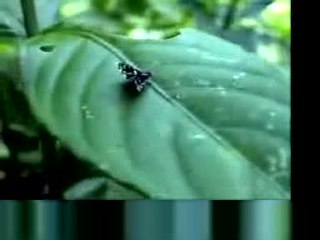
Ant mimicry or myrmecomorphy is mimicry of ants by other organisms; it has evolved over 70 times. Ants are abundant all over the world, and potential predators that rely on vision to identify their prey, such as birds and wasps, normally avoid them, because they are either unpalatable or aggressive. Some arthropods mimic ants to escape predation, while some predators of ants, especially spiders, mimic them anatomically and behaviourally in aggressive mimicry. Ant mimicry has existed almost as long as ants themselves; the earliest ant mimics in the fossil record appear in the mid-Cretaceous alongside the earliest ants.

Choreutidae, or metalmark moths, are a family of insects in the lepidopteran order whose relationships have been long disputed. It was placed previously in the superfamily Yponomeutoidea in family Glyphipterigidae and in superfamily Sesioidea. It is now considered to represent its own superfamily. The relationship of the family to the other lineages in the group "Apoditrysia" need a new assessment, especially with new molecular data.
Brenthia albimaculana is a species of moth of the family Choreutidae. It is found in Indonesia, New Guinea and Australia.
Brenthia quadriforella is a species of moth of the family Choreutidae. It was described from New Britain, but is also present in country of Australia and Fiji.
Brenthia hibiscusae is a moth of the family Choreutidae. It is known from Cuba, Puerto Rico and Venezuela.
Brenthia gregori is a moth of the family Choreutidae. It is known from Cuba and the Virgin Islands.

Brenthia is a genus of moths in the family Choreutidae.
Brenthia gamicopis is a species of moth of the family Choreutidae. It is found in Uganda.
Brenthia leptocosma is a species of moth of the family Choreutidae. It is found on Mauritius and Réunion in the Indian Ocean.
Brenthia leucatoma is a species of moth of the family Choreutidae. It is found in Ethiopia and South Africa.
Brenthia virginalis is a species of moth of the family Choreutidae. It is found in South Africa.
Brenthia octogemmifera is a species of moth of the family Choreutidae. It is found in the Republic of Congo, Equatorial Guinea and Nigeria.

Brenthia hexaselena is a species of moth of the family Choreutidae. It is found in Costa Rica. It is a rare example of a prey animal mimicking its predator.
Brenthia buthusalis is a species of moth of the family Choreutidae. It was described by Francis Walker in 1863. It is found in Sri Lanka and India.

Brenthia caelicola is a species of moth of the family Choreutidae. It was described by Edward Meyrick in 1910. It is found on the Kai Islands of Indonesia.
Brenthia coronigera, commonly known as the metalmark moth, is a species of moth of the family Choreutidae. It was described by Edward Meyrick in 1918. It is found in the Bengal region of what was British India.
Brenthia nephelosema is a species of moth of the family Choreutidae. It was described by Alexey Diakonoff in 1978. It is found in Fujian, China.
Brenthia ocularis is a species of moth of the family Choreutidae. It was described by Cajetan Felder, Rudolf Felder and Alois Friedrich Rogenhofer in 1875. It is found on Java.
Locomotor mimicry is a subtype of Batesian mimicry in which animals avoid predation by mimicking the movements of another species phylogenetically separated. This can be in the form of mimicking a less desirable species or by mimicking the predator itself. Animals can show similarity in swimming, walking, or flying of their model animals.




